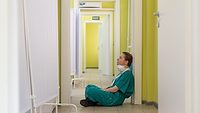Protecting our Home Healthcare Heroes

We are living in unprecedented times. As the deadly COVID-19 sweeps its way across the globe, millions of workers providing essential services are putting their lives on the line for their communities and the rest of the world. The workers risking their lives the most are healthcare workers – brave souls on the front lines of the outbreak response, who are exposing themselves to infection and other health and safety hazards for the safety of the public. But in addition to COVID-19 exposure, these people already face a multitude of other safety risks including long working hours, psychological stress, fatigue, burnout and physical and psychological violence.
Protecting Those on the Frontline
As of April 15, nearly 9,300 U.S. healthcare workers contracted COVID-19, and 27 have died. In some countries, up to 10% of health workers are being infected by coronavirus.
Until we know more about how COVID-19 spreads, the Occupational Safety and Health Administration recommends using a combination of standard precautions, contact precautions, airborne precautions, gowns, gloves and eye protection, such as goggles and face shields, to protect healthcare workers who are exposed to the potentially fatal virus.
Providing home and community healthcare has always been an unpredictable work environment. But with the ever-looming threat of COVID-19 and an increased need for home and community services, these working conditions are even more volatile and potentially dangerous for healthcare workers. In addition to the deadly pandemic, these brave workers are exposed to a number of other unique hazards as well.
As the baby-boom population ages, an increasing number of US patients and clients are receiving health and social care in the community. As a result, more and more nurses and workers are venturing out into the community – alone – to provide care to these people and their families. In 2017, the Paraprofessional Healthcare Institute (PHI) reported that there were more than 2 million home healthcare workers in the US. This number nearly doubled in 10 years, from 840,000 in 2007 to two million in 2017. Additionally, the US Bureau of Labor Statistics says employment of remote home healthcare workers, including home health aides and personal care aides, is projected to grow 36% from 2018 to 2028 – “much faster than the average for all occupations.”
Increasing Demand for Home Care
But on top of a rapidly growing population of aging adults in this country, there are other rationales for an increasing demand for home healthcare. First of all, it can be less costly to the healthcare system to provide care in the comfort of the patient’s home. Furthermore, with advancements in technology, providers can deliver a diverse range of care in a variety of home and community settings, calling for more healthcare staff to work outside of hospitals and clinics. Home care also has other benefits in that patients can experience more comfort, better sleep and less anxiety – they are also less likely to experience infections and recover faster. Additionally, recovery is better supported in a home setting, granting workers the ability to look at the big picture of the patient’s health, considering factors like nutrition and sleep.
Increasing Safety and Legal Risks
With this shift in healthcare provision, also comes unique, somewhat-unknown risks for workers and patients. The Government Accountability Office says that instances of workplace violence in healthcare is increasing overall, with more than 730,000 assaults taking place between 2009 and 2013. This figure showed home health, psychiatric and personal care aides bearing the highest risk. In another report, PHI found that in 2016, the injury rate per 10,000 workers was 144 injuries among personal care aides, 116 among home health aides and 337 among nursing assistants. In comparison, the overall injury rate across all occupations in the US was 100 per 10,000 workers. In another study conducted by the University of Massachusetts, it was found that roughly seven percent of healthcare aides reported experiencing physical violence while close to 20 percent reported experiencing verbal violence from patients and clients. Accordingly, if your home health care team’s safety and wellbeing is at higher risk, so is your organization’s chance of litigation.
Complex and Unpredictable Risks
To alleviate these safety hazards, companies need to know what they are facing. The US Department of Labor for Occupational Safety and Health Administration defines hazards as “any source of potential damage, harm or adverse health effects on something or someone.” Hazard and safety risks exist in many workplaces, but they are particularly prevalent for traveling healthcare workers, especially during these times. Employers need to identify and mitigate these hazards in order to minimize the probability of an accident or injury occurring. Due to the complexities and unpredictability of home healthcare, the true challenges lie in identifying the potential risks, and determining ways to mitigate those risks with both your team and your patients.
In her scholarly review, Safety risks associated with physical interactions between patients and caregivers during treatment and care delivery in Home Care settings, Sue Hignett found that significant safety risks for home healthcare workers are numerous. They include, “awkward [physical] working positions, social environment issues (additional tasks and distractions), abuse and violence [from patients and their family], inadequate team (peer) support, problems with workload planning, needle stick injuries and physical workload (moving and handling patients).” Other less-visible hazards exist in unsanitary homes, temperature extremes and in homes without safe drinking water.
The types of violence home healthcare workers are susceptible to, are actually more disturbing than the number of risks at hand. While a majority of violence is verbal, home healthcare workers also occasionally experience domestic violence, physical and sexual assault and battery, sexual harassment or stalking.
In addition to these considerable safety hazards, the Safe Home Care Project found that home healthcare workers providing care are vulnerable to psychological and emotional side effects such as burnout. Burnout is especially prevalent due to long shifts, unpredictable work environments and the isolation of working alone with limited supervision or peer support.
What can you do?
With the COVID-19 pandemic, the diversity of home care patients and their ailments, as well as a wide variety of living situations, can present unique challenges that differ from working in a hospital or clinic. But because of the unprecedented growth in both demand for home healthcare provisions, as well as the unique safety risks for caregivers, the need for employers to protect their remote workers is greater than ever.
There are a number of easy steps that employers can take to protect their healthcare workers in patients’ homes and in the community.
- Assess the situation and determine if the patient is displaying COVID-19 symptoms.
- Equip all workers with appropriate personal protective equipment (PPE) such as gloves, mask/face shield and gown.
- An International Association for Healthcare Security and Safety (IAHSS) Foundation report says that it is important for employers to have a comprehensive workplace violence prevention program in place. This type of program includes environmental modifications, work practice changes, implementation of policies and practices, safety training, use of security and law enforcement, management commitment, risk assessment and integration with the security program and surveillance of violent events.
- Especially in high-crime areas, send your workers out in pairs.
- Create a list of the hazards and assess them carefully for each work environment.
- Consider past incidents that have taken place and assess what went wrong.
- Provide thorough training and education to both the remote worker and the team member assigned to respond if there is an emergency.
- Report all situations where being alone increased the severity of the situation. Look at this information with your team and make changes to company policy where necessary.
- Establish an easy, accessible, and dependable check-in procedure. Whether it’s a scheduled phone call or an online app, regular check-ins will ensure that constant contact is kept with all workers.
- Try to plan higher-risk work to be done during regular business hours or when a fellow worker is available to help in case of an emergency.
- If the budget allows, enroll your remote health care workers in a self-defense course.
What Can They Do?
On the other end of the safety spectrum, there are several proactive steps the remote healthcare worker can take to make sure they are safe while working.
- Ensure you have the proper PPE for your job during COVID-19 conditions.
- Make sure your hands are being washed and/or sanitized prior to putting on gloves and after taking gloves off.
- Change gloves if you touch your face – eyes, nose or mouth – or cover a cough or sneeze with your hands while wearing gloves.
- After working with a patient, change gloves, mask and gown.
- Carry a bag with several clean masks in it, as well as a plastic bag that can be used to safely store used masks until they can be washed at home.
- It might be obvious, but make sure you lock your valuables and work gear in your car, keeping any bags or possessions out of sight.
- Keep your guard up. Unlike the hospital, the patient’s home is an unpredictable and uncontrolled environment. Pay attention to red flags in the patient’s home such as aggressive behavior, weapons, as well as drugs and alcohol.
- Make sure your cell phone is fully charged and accessible at all times. This will allow you to signal an emergency with a number of features, including pressing a panic button or shaking for an emergency.
- When arriving at a patient’s home, call your employer and notify them of where you will be located and for how long. You can also use a GPS monitoring tool or app so that your employer will know where you are automatically.
- If it’s your first visit to a patient’s home, make sure you have clear directions to safely navigate an unfamiliar neighborhood.
- Be cautious around pets and animals on the patient’s property. Local animals – even pets – can be unpredictable and dangerous.
- Don’t overexert yourself when lifting or moving patients. In these cases, try to use a buddy system.
- When entering a patient’s home, refrain from removing your shoes if possible - you might slip or step on a nail or piece of glass. If this is not an option, bring a pair of clean shoes to wear in the house or bring disposable surgical shoe covers.
- Always be aware of where the exits are and make sure you have a clear path to them.
- Always keep your cell phone in an accessible place, like your pocket or in a holster, for easy and quick use if necessary.
Connect, Monitor and Locate
While these lists of tips and recommendation may be exhaustive, not all will apply to your organization and team. When exploring methods and developing plans to protect your remote health care workers, be mindful when identifying which methods are a suitable fit for your organization. Most importantly, when your employees are out in the community providing care in these dangerous times, make sure you have the means to connect, monitor and locate them to resolve emergency situations when they happen.
Resources for Your Team
It is quite evident that healthcare workers face more hazards and challenges than any other service deemed essential during the pandemic.
Because these selfless people are putting their lives on the line to protect us and our families, it is our responsibility to do everything possible to make sure they are safe.
In addition to the tips above, here are a number of resources that healthcare workers can access during this extraordinary and very difficult time.
Looking for a reprint of this article?
From high-res PDFs to custom plaques, order your copy today!






